Use 'Print preview' to check the number of pages and printer settings.
Print functionality varies between browsers.
Printable page generated Thursday, 25 April 2024, 4:40 AM
Study Session 3 Water Sources and their Characteristics
Introduction
Water collection for domestic use can be traced back to 560 BC when rainwater harvesting was practised in the Axumite Kingdom. In those days, rainwater was collected and stored in ponds for agriculture and water supply purposes. Evidence for this is in documented literature and may be observed in visible remains of ponds (Seyoum, n.d.). The history of modern piped water supply in Ethiopia began in 1924 when a piped supply was established from the Kebena River to the patriarch’s compound and Menelik Hospital in Addis Ababa, using an 80-mm pipe. Until the inauguration of the Gefersa Dam in 1951 the town of Addis Ababa was supplied from wells and springs (AAWSA, 2011).
Learning Outcomes for Study Session 3
When you have studied this session, you should be able to:
3.1 Define and use correctly all of the key words printed in bold. (SAQ 3.1)
3.2 Identify the different sources of water for urban supply, describe their characteristics and explain how water is abstracted from them. (SAQ 3.2)
3.3 Identify means of protecting water sources. (SAQs 3.3 and 3.4)
3.4 Describe briefly the factors to be considered in water source development. (SAQ 3.5)
3.1 Types of water source
In Study Session 1 you were introduced to the three main sources of water: groundwater, surface water and rainwater. In arid regions where seawater is accessible (such as in the Middle East), desalination (the removal of salts from water) is used to generate drinking water. Another potential source of water is treated wastewater – you will learn more about this in Study Session 11. In practice, the term ‘water source’ can be used to mean both the origin of the water and also the place where people get their water (spring, piped supply to household tap, water point, well, etc.).
Water sources can be classified as protected or unprotected. Protected sources are covered by stonework, concrete or other materials that prevent the entry of physical, chemical and biological contaminants. Typical characteristics of a protected water source are given in Box 3.1.
Box 3.1 Characteristics of a protected water source
- The water source is fully enclosed or capped and no surface water can run directly into it.
- People do not step into the water while collecting it.
- Latrines, solid waste pits, animal excreta and other sources of pollution are located as far away as possible from the water source and on ground lower in elevation than the water source.
- There is no stagnant water within 5 metres of the water source.
- The water collection buckets or hand pump at the source are kept clean.
Why do you think there should be no stagnant water within 5 metres of a water source?
It could encourage animals to come there for water, and they could contaminate the water source. Stagnant water can also become a breeding site for mosquitoes.
Unprotected sources are those with no barrier or other structure to protect the water from contamination. All surface water sources, such as lakes, rivers and streams or poorly constructed wells, are examples of unprotected sources. Water from unprotected sources cannot be considered safe to drink unless it has been treated.
The terms ‘improved’ and ‘unimproved’ are also used to describe water sources and are broadly equivalent to ‘protected’ and ‘unprotected’. WHO /UNICEF categories of water sources are defined in this way, as you can see in Figure 3.1. This shows the drinking water ladder, which describes the steps in improvement of quality of water supply depending on the type of source. Surface water is at the bottom of the ladder and piped water into the household is at the top. There are a number of improved and unimproved sources between these two, several of which are described in later sections of this study session.
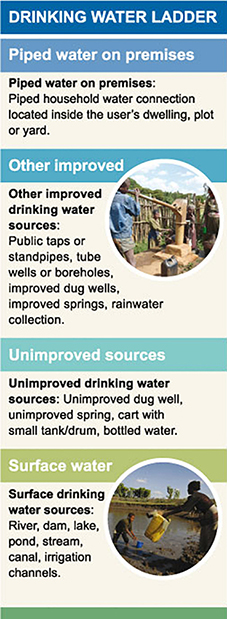
3.2 The situation in Ethiopia
Figure 3.2 shows estimated trends in drinking water coverage in Ethiopia. Each of the columns shows the percentage of drinking water that is supplied by surface water, other unimproved sources, piped supply and other improved sources, for the years 1990 to 2012.
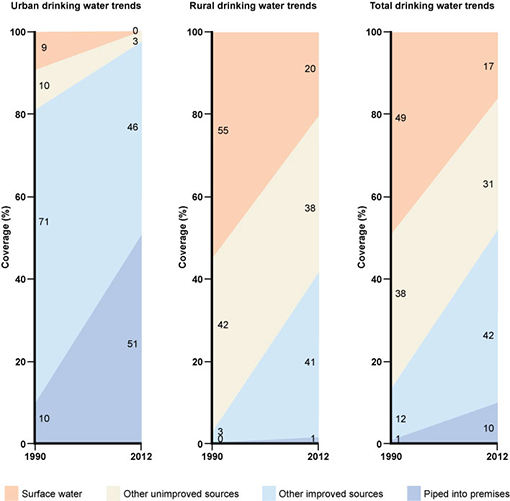
Look at Figure 3.2 and calculate the percentages of water supplied from improved water sources to urban populations and to rural populations in Ethiopia in 2012.
For urban populations, piped supplies to premises account for 51% and other improved supplies 46%, so the total is 97%. For rural populations, piped supplies to premises are only 1%, and other improved supplies are 41%, making a total of 42%.
One reason for the low coverage of rural premises is that the rural population is dispersed, and therefore difficult to serve easily. In urban areas, people live closer together and populations are more concentrated in given areas; therefore pipes can be laid more easily (and with less expense) to cover a large population.
3.3 Groundwater
Groundwater was defined in Study Session 1 as water that is found underground within rocks. Its presence depends primarily on the type of rock. Permeable rocks have tiny spaces between the solid rock particles that allow water and other fluids to pass through and to be held within the rock structure. The layers of rock that hold groundwater are called aquifers. Figure 3.3 shows how groundwater in an aquifer is replenished by rain and other forms of precipitation (any form of water, such as rain, snow, sleet or hail that falls to the Earth’s surface, shown in the diagram as ‘recharge’) that has percolated (passed through a porous substance, or through small holes) downward into the aquifer. The level of water below ground is called the water table. Groundwater can be extracted from wells or collected from springs.
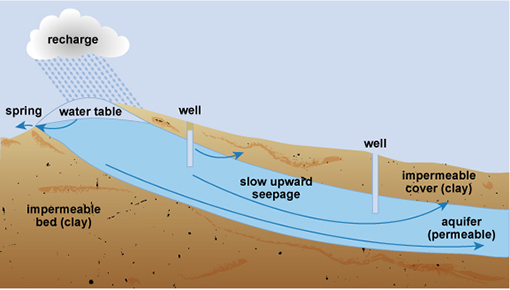
The depth that groundwater is taken from and the types of permeable rock it has passed through are important factors that affect its quality. Groundwater, particularly from deep sources, may provide water of good microbiological quality. This is because bacteria, protozoa, viruses and helminths are filtered from the water as it passes through the layers of soil and rock. Groundwater sources are therefore preferable to surface water sources. However, groundwater can contain chemical contaminants, as indicated in Table 3.1, which lists the advantages and disadvantages of using groundwater as a water source.
| Advantages | Disadvantages |
Likely to be free of pathogenic bacteria Usually free of turbidity and colour Can usually be used without further treatment Can often be found in close vicinity to consumers Economical to obtain and distribute The water-bearing soil or rock provides a natural storage point | Often has a high mineral content (i.e. has naturally occurring substances that are not from living organisms) such as calcium, magnesium, iron and manganese Usually requires pumping for extraction May have a high level of bicarbonate, carbonate and chloride Poor in oxygen content Can contain chemical contaminants such as arsenic, fluorides and nitrates If it gets polluted, treatment can be difficult to achieve |
Several factors influence the likelihood of groundwater becoming contaminated from a polluting source such as a pit latrine. The geology is important because in areas with permeable rocks, or where there are small cracks in the rock formation, fluids can pass through more easily into the aquifer. Other factors include the depth of the pit and its vertical distance from the water table. In Ethiopia, federal guidelines state that latrines must be sited at least 30 metres from any water source to be used for human consumption and if on sloping ground be lower than the source (MoH, 2004).
Why should a well be located uphill from any possible sources of pollution?
The natural flow of the groundwater follows the law of gravity, and will be downhill. The well should be sited so that any pollutants going into the soil that enter the groundwater do not get into the water in the well. So, the best place for a well would be uphill of the pollutant source.
3.3.1 Wells and boreholes
Wells and boreholes can be described by their depth, or by the way they are constructed. They may also use different types of pump at the surface to raise the water.
Shallow wells
Shallow wells and boreholes usually have a depth of less than 30 m, although they can be as much as 60 m deep, especially in very dry areas of Ethiopia where the water table is low. Figure 3.4 is a diagram of a protected hand-dug well. Wells can be excavated by hand if the soil is not too hard or the water table is high. Hand-dug wells have a relatively large diameter because they have to be wide enough for a person to be able to stand inside and dig.
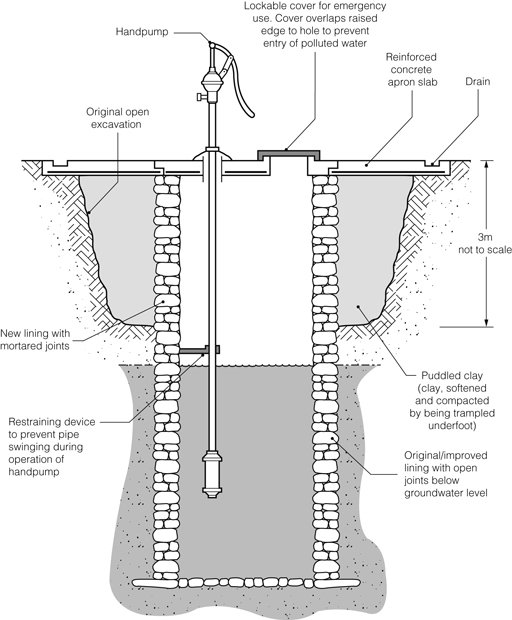
The inside wall of the top 3 m or so of the dug well should be made waterproof by constructing a well casing (lining). In small-diameter wells the casing can be a pipe, but in large wells the casing needs to be constructed in concrete from the top of the well down to a minimum depth of 3 m. The casing of the well should also be extended for a minimum of 60 cm above the surrounding ground level to prevent the entrance of surface run-off – that is, water that runs off the surface of the land, carrying debris, wastes and other pollutants with it as it flows. A concrete cover should be fitted over the well casing, as in Figure 3.5, to prevent dust, insects, small animals and any other contaminants from falling in.
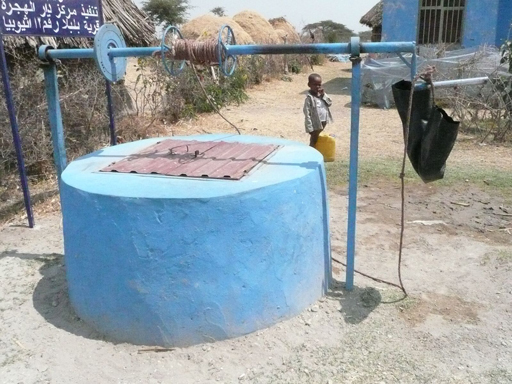
Depending on the depth of the well, water may be drawn up by a bucket and rope or by using a pump. Hand pumps, such as the one in Figure 3.6, are built over the well and the concrete cover extends to cover the surrounding ground. The immediate area of the well should preferably be fenced to keep animals away. The area surrounding the well should be graded off (i.e. should slope away from the well) in order to prevent the flow of storm water run-off into the well. Any pipework associated with the pump that enters the well needs to have watertight connections so that it operates efficiently. The well, pump, pipework and associated structure should be regularly disinfected using chlorine solution to eliminate pathogens and ensure the water is safe to drink.
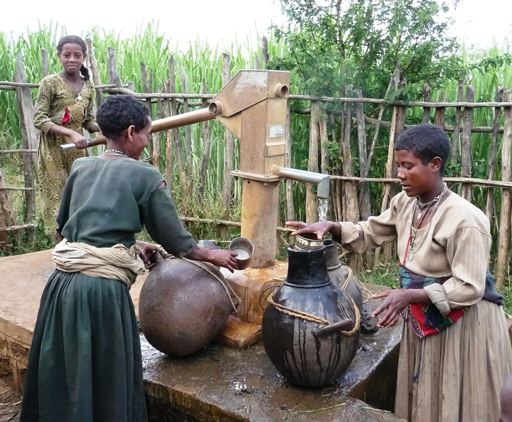
Water can also be drawn from a well using a rope pump (Figure 3.7). A long continuous loop of rope, with washers at regularly spaced intervals, runs around a wheel at the top of a well and around a smaller roller encased below the water line. The rope runs through a PVC pipe and, as the wheel is turned, water is drawn up the pipe by suction. A rope pump can be made from recycled parts, such as bicycle wheels, scrap metal and plastic, and it can be mended quickly and cheaply.
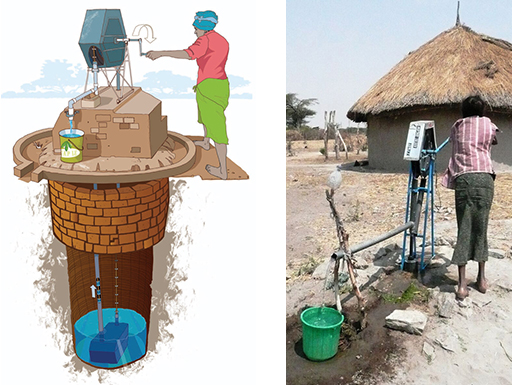
Deep wells or boreholes
These are wells that have been sunk with drilling machines designed for constructing water extraction boreholes (Figure 3.8). These machines are able to penetrate through harder material that cannot be tackled by hand digging and can therefore pass through at least one impermeable layer of rock to a productive aquifer underneath. They typically obtain water from depths ranging from 30 to 60 m, but large urban supply boreholes can be much deeper than this. A casing of metal or plastic pipe is usually necessary to line the borehole and prevent the soil and rock from collapsing into it (Figure 3.9). The lower part of the casing must have suitable openings to allow water to enter the borehole from the aquifer, although in hard rocks – such as some of the volcanic aquifers of Ethiopia – the borehole can be left open and will not collapse.
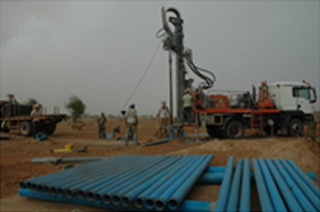
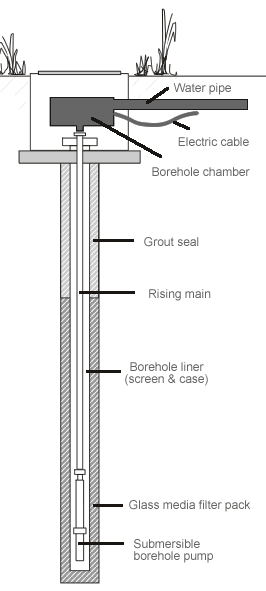
At the surface, different types of pump may be used including hand pumps like the one in Figure 3.6. For larger boreholes in urban areas electric or diesel-powered pumps would be used.
3.3.2 Springs
Groundwater may emerge above ground as a spring. This happens in locations where the water table reaches the surface, or where the boundary between a permeable layer of underground rock and an impermeable layer reaches the ground surface, as shown in Figure 3.3. Springs are normally found at the foot of mountains and hills, in lower slopes of valleys, and near the banks of major rivers. The water emerging at a spring may vary in volume and contamination levels, in response to the amount of rainfall. Springs are likely to be polluted by direct contamination from run-off seeping through the topsoil unless the surrounding land area is protected. A spring supply issuing from a deep, water-bearing layer, rather than a permeable layer near the surface, can produce both a consistent volume and a better-quality supply.
Spring source protection
Whether the spring originates from shallow or deep rock layers, animals should be excluded from the surrounding area by a stock-proof fence. Springs should be protected from flooding and surface water pollution by constructing a deep diversion ditch above and around the spring. The ditch should be constructed so that it collects surface water running towards the spring and carries or diverts it away. It needs to be deep enough to carry all surface water away, even in a heavy rainstorm.
Small springs are typically protected by a ‘spring box’ (Figure 3.10), which is constructed of brick, masonry or concrete, and is built around the spring so that water flows directly out of the box into a pipe or cistern, without being exposed to outside pollution such as run-off, bird droppings and animals. The spring box should have a watertight cover with a lock. Larger springs serving towns are protected in a similar way. Figure 3.11 shows the protected spring that supplies water to the city of Bahir Dar.
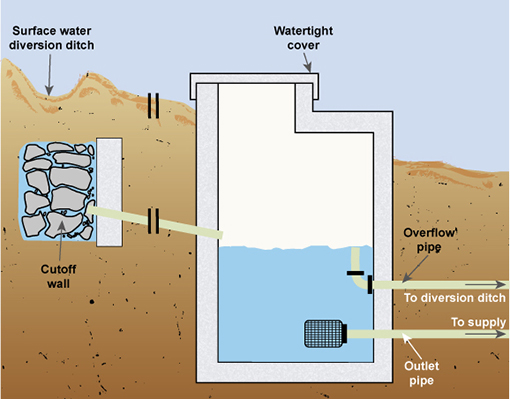
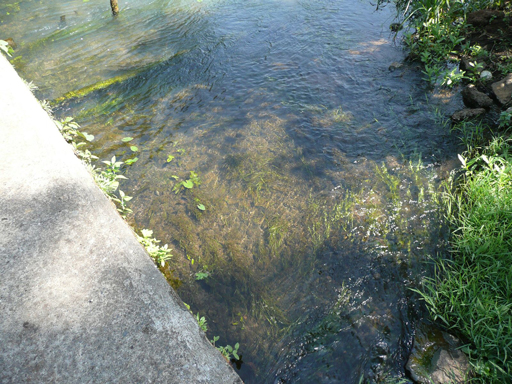
3.4 Surface waters
The quality and quantity of surface water varies from one place to another and over time, due to factors such as geology, climate and surrounding land use.
Why is surface water classed as an unimproved source?
Because rivers and lakes can be easily contaminated by run-off that washes pollutants into the water. Lack of effective sanitation and open defecation make contamination by microbiological pathogens much more likely.
The variable quality of surface water means it has to be treated to make it safe for domestic consumption. There are several different methods of water treatment at large and small scale that are described in later study sessions. The quantity of water in rivers and lakes obviously varies with rainfall and there can be wide fluctuations at different times of year. To ensure year-round supply, dams can be constructed to create reservoirs from which water can be extracted prior to treatment. For example, Figure 3.12 shows part of the city of Gondar with the Angareb Reservoir in the background, which was created when the river was dammed to provide water for the city.
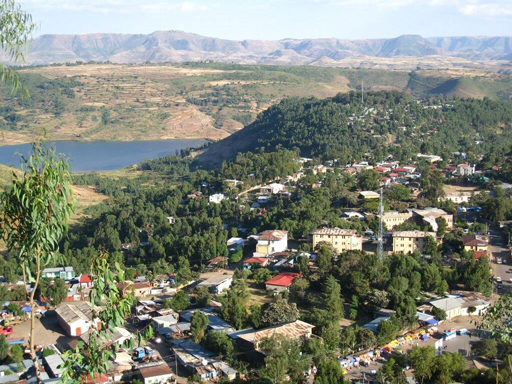
3.5 Rainwater
In regions where rainfall is abundant and frequent, rainwater can be a good source of water supply for individual families and small communities. The storage of rainwater is particularly important in areas with a long dry season, or where groundwater or surface water is difficult to obtain or polluted. The term rainwater harvesting is sometimes used. It simply means collecting, or harvesting, rainwater as it runs off from hard surfaces and storing it in a tank or cistern. Rainwater has several advantages. It is free, relatively clean and usually reliable, even if it rains only once or twice a year, and a rainwater harvesting system can be easily constructed and maintained at low cost. Although mainly found in rural areas, rainwater harvesting can also be useful in an urban situation.
Rainwater can be collected in several ways:
Roof catchments
Rainwater can be collected from house roofs made of tiles, slate, (corrugated) galvanised metal or equivalent. Pipes feed water from the roof and gutters into a collection tank where it can be stored until needed (Figure 3.13).
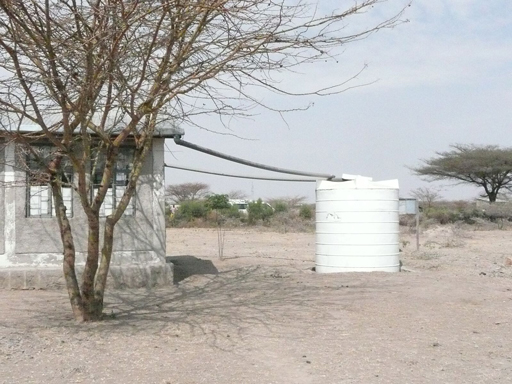
If rainwater is used for water supply, it is important to ensure that it is not contaminated by improper methods of storage, or by bird droppings and leaves from the roof that it is collected from. Rainwater may be also be contaminated by pollutants in the air, dust, dirt, paint and other material on the roof or in roofing materials. All of these contaminants can be washed into the storage tank or cistern.
To protect the water, various precautions are needed. The tank must be completely covered and well-maintained. The roof and gutters should be cleaned regularly, especially before the start of the wet season. It may be necessary to divert the first rainwater away from the tank so that dust and dirt are washed away. Leaves and other larger debris can be prevented from entering the tank by placing a mesh screen between the guttering and the pipe that leads to the tank; the mesh screen will need to be cleaned regularly.
Ground catchments
These are systems that collect and store rain falling on an area of ground (Figure 3.14). The amount of rainwater that can be collected depends on whether the area is flat or sloping, and on the permeability of the top layer of the ground. These systems require space so are only appropriate in rural areas, where they can serve small villages and households for livestock and vegetable growing.

Sand dams
In arid areas where there is a dry, sandy riverbed and the rain falls once or twice a year, a collection system known as a sand dam can be used to store water. A sand dam (Figure 3.15) is a concrete wall (1 to 5 m high) built across a seasonal sandy riverbed. During the rainy season, a seasonal river forms and carries sand and silt downstream. The heavy sand accumulates behind the dam, while the lighter silt washes downstream over the dam wall. Within one to four rainy seasons the dam completely fills with sand. However, up to 40% of the volume held behind the dam is actually water stored between the sand particles. The water can be abstracted from the sand dam via a slotted pipe buried in the sand that either passes through the dam wall or is connected to a simple hand pump situated on the river bank.
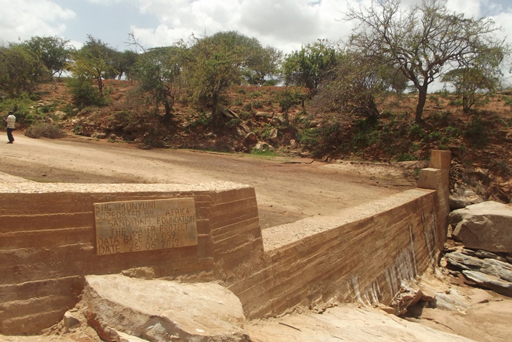
3.6 Water source development
One of the main duties of a water supply provider is to ensure that a safe and plentiful water supply is available to all segments of a community at a reasonable cost. This may mean seeking new water sources to satisfy demand. Identifying potential new sources and assessing their viability prior to development is a skilled technical task that requires several different factors to be assessed. These factors include:
- Volume of water required: This will depend on demand, which relates to the number and type of potential users. Will the new source be able to meet the demand of all users? Have future increases in demand and population growth been taken into consideration?
- Quality: Is the water from a safe and protected source? If not, what will be the level of treatment needed and how will this be achieved? What is the risk of pollution of the source?
- Seasonal variations: Is the new water source reliable, or is it vulnerable to seasonal variations in the availability of water? How will this be accommodated?
- Distance between source and users: How far must the water be transported? What is the sort of distribution system that will be needed? What are the engineering requirements for the system?
- Cost: Following on from all the above, what is the cost of developing the new source (both capital and continuing operating and maintenance costs) into the future?
- Environmental impact: What are the predicted environmental consequences of developing the water source? Will the benefits of the new supply outweigh any disadvantages?
- Sustainability: Can the water source be developed and used in such a way that it does not compromise the future ability to supply water? For example, the rate of abstraction from a spring should not exceed the rate of natural replenishment.
Answers to all of these questions and more, together with detailed surveys, assessments and analyses, will be required to identify possible new water sources. Mentioned in the list above is the possibility of pollution of the water source. There are many possible sources of pollution and these will be discussed in the next study session.
Summary of Study Session 3
In Study Session 3, you have learned that:
- Protected water sources (often called ‘improved’ water sources) are those that have barriers against contaminants and provide water that is safe to drink.
- The drinking water ladder describes the steps in improvement of quality of water supply.
- In Ethiopia in 2012, protected water sources supplied 97% of the water to urban populations, and 42% of the water to rural populations.
- Urban areas can obtain water supplies from groundwater, surface water and rainwater.
- Groundwater sources such as shallow wells, deep wells (boreholes) and springs should be protected against contamination by animals and surface run-off.
- Disinfection of the equipment at wells should be undertaken regularly.
- Surface waters are more prone to contamination than groundwater, and usually require treatment.
- Rainwater has several advantages as a water source.
- New water source development has to consider the capacity of the new source to supply water for a considerable time, and take into account factors such as raw water quality, seasonal variation, distance from consumers, cost, environmental impact and sustainability.
Self-Assessment Questions (SAQs) for Study Session 3
Now that you have completed this study session, you can assess how well you have achieved its Learning Outcomes by answering these questions.
SAQ 3.1 (tests Learning Outcome 3.1)
Match the following words to their correct definitions.
Using the following two lists, match each numbered item with the correct letter.
permeable rocks
sand dam
water table
rainwater harvesting
protected water sources
percolated
drinking water ladder
run-off
unprotected water sources
precipitation
aquifers
a.something that describes the steps in improvement of quality of water supply
b.rocks that allow water to pass through them
c.the level of water below ground
d.layers of rock underground that hold water
e.passed through a porous material or through small holes
f.any form of water that falls on the Earth’s surface
g.rainwater that runs off land
h.water sources that have structures to prevent the entry of contaminants
i.the process of collecting and storing rainwater
j.a means of storing water using sand and a dam
k.water sources that do not have protective structures to stop them being contaminated
- 1 = b
- 2 = j
- 3 = c
- 4 = i
- 5 = h
- 6 = e
- 7 = a
- 8 = g
- 9 = k
- 10 = f
- 11 = d
SAQ 3.2 (tests Learning Outcome 3.2)
Place the following phrases alongside the appropriate water source:
quality can change with location and season; difficult to treat if contaminated; usually requires treatment; free of charge; can be easily polluted by industry and agriculture; likely to be free from pathogenic bacteria; can be polluted by bird droppings; can often have a high mineral content.
| Water source | Characteristics |
| groundwater | |
| surface water | |
| rainwater |
Answer
| Water source | Characteristics |
| groundwater |
|
| surface water |
|
| rainwater |
|
SAQ 3.3 (tests Learning Outcome 3.3)
Suppose that inhabitants of a village obtain water from a spring. What advice would you give to the users about the prevention of contaminants entering the spring?
Answer
The users of the spring should be advised to:
- avoid open defecation around the spring
- not construct latrines above the spring because of the danger of contaminating the groundwater
- use latrines properly
- keep animals away from the spring.
SAQ 3.4 (tests Learning Outcome 3.3)
Look at Figure 3.16, which shows a hand pump over a well. What would you recommend should be done to improve protection of this water source?
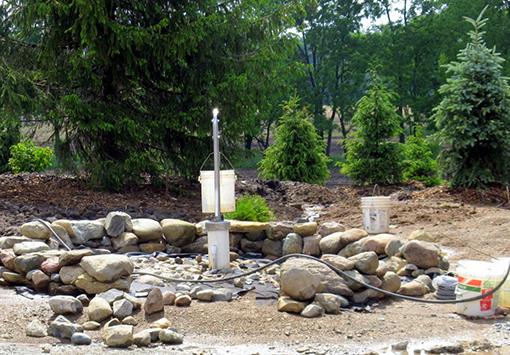
Answer
There should be a raised, smooth-sloping area around the pump for user safety and also so that any surface water or spillage runs off. The rock wall should be increased in height and a gate installed so that no animals can get near the pump and contaminate the area.
SAQ 3.5 (tests Learning Outcome 3.4)
Which of the following statements is false in relation to the development of a new water source? In each case explain why it is incorrect.
- A.The water source has to be reasonably close to the consumers of the water.
- B.Its environmental impact has to be ascertained.
- C.The effect of the seasons has to be considered.
- D.The quality of the raw water is immaterial, since modern treatment techniques can render it safe for drinking.
- E.The long-term viability of the source is important.
Answer
D is false. It is better to find a water source that is of good quality so that minimal treatment is required. This will keep costs low.
SAQ 3.6 (tests Learning Outcome 3.4)
List the factors that make a water source ideal to use.
Answer
The following are important factors for an ideal water source:
- capable of providing a supply that satisfies the anticipated demand and, in the case of groundwater, the rate of extraction not exceeding the rate of replenishment
- good water quality
- near to the consumers
- economical to use
- abstraction having minimal environmental impact.